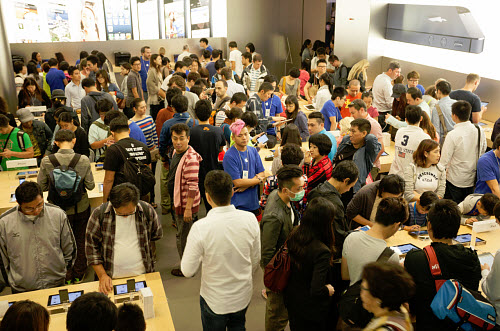Brick and mortar stores had been feeling threatened by smartphone shoppers, but that may not be the case.
As mobile commerce has been picking up at a substantial rate, retailers in brick and mortar locations have been concerned that consumers may begin to be lured online by the ability to shop for a better deal, no matter where they are, instead of heading out to real world stores.
A recent study has shown that shoppers are returning to stores on an increasing basis, to shop in person.
This trend has shown itself in the research of several companies that have been looking into mobile commerce, including Telefonica SA, Tumblr, and Yahoo Inc. This was announced at the Digital Life Design conference that was recently held in Munich, Germany. Though the last few years have shown a greater growth in online shopping than at in-store locations, the mall is beginning to take hold of some of its former share, according to the researcher, Euromonitor’s data.
Many in the industry feel that as popular as mobile commerce may be, real life interaction has been missed.
 According to the Tumblr head of creative strategy, David Hayes, “People are craving real-life interaction for shopping.” Hayes stated that he has worked with Levi Strauss & Co., and Gap Inc. in order to encourage consumers to attend events such as promotional parties and music performances being held in stores. He added that “There’s a trend going from URL to ‘IRL’ – ‘in real life’.”
According to the Tumblr head of creative strategy, David Hayes, “People are craving real-life interaction for shopping.” Hayes stated that he has worked with Levi Strauss & Co., and Gap Inc. in order to encourage consumers to attend events such as promotional parties and music performances being held in stores. He added that “There’s a trend going from URL to ‘IRL’ – ‘in real life’.”
While online and mobile commerce have been turning companies such as Alibaba and Amazon into massive giants that would seem to be virtually unstoppable, some brick and mortar retailers are discovering that the hands-on experience and in-person interaction that they have to offer customers has been giving them an advantage that has been enough to bring people back. The revenue generated through in-store experience is, according to Euromonitor data, going to grow to 4.9 percent by 2019. Comparatively, that figure had been 1.6 percent in 2013, while the growth of online sales is supposed to slow down to 12 percent by 2019 from having been 21 percent in 2013.
An analysis of comScore data has revealed that 14 percent of all consumer disposable income was spent online.
A report issued by comScore, based on an analysis of their data has shown that the holiday season was working out to be a successful one for the majority of retailers, as spending was slightly higher than had been anticipated, partly because of the contribution of mobile shopping.
Desktop and laptop based shopping had increased by 15 percent from November 1 to December 21.
That was higher than the predicted increase by comScore, which had been 14 percent, and was higher than the growth that was recorded over the same period of time in 2013, which was 10 percent. That figure included the contribution made by mobile commerce, which represented about half of the online traffic during that time. comScore has reported that they estimate that over 2013, the 2014 m-commerce was up by about 25 percent. Total retail commerce was recorded at 17 to 18 percent higher than it was in 2013.
comScore estimated that during the fourth quarter, desktop and mobile shopping would take up 14 percent of discretionary spending.
 Mobile commerce has been experiencing an especially large growth and, according to the data from comScore, it has been boosting the shift toward online spending that has been taken by consumers. In terms of holiday spending penetration, it now represents about 15 percent.
Mobile commerce has been experiencing an especially large growth and, according to the data from comScore, it has been boosting the shift toward online spending that has been taken by consumers. In terms of holiday spending penetration, it now represents about 15 percent.
According to figures from Outperform, the large retailer, Target, has made its way up to include itself among the top online retail sites throughout the most important shopping period of the year. In fact, it was ranked as being in fourth place, in 2014. This was greatly driven by the Cartwheel mobile app. comScores data revealed that 62 percent of the visits to Target over mobile were generated through that app, which rivals Amazon.com, the current e-commerce leader (at which 66 percent of visits are mobile based).
The average percentage of online visits from mobile shopping consumers is 30 percent, according to comScore, showing that target is well above that level. It is clear that the retailer’s strategy to use the Cartwheel app to target the Millennial generation is proving to be highly effective, so far (particularly as it was offering free shipping during the holidays).
 According to the Tumblr head of creative strategy, David Hayes, “People are craving real-life interaction for shopping.” Hayes stated that he has worked with Levi Strauss & Co., and Gap Inc. in order to encourage consumers to attend events such as promotional parties and music performances being held in stores. He added that “There’s a trend going from URL to ‘IRL’ – ‘in real life’.”
According to the Tumblr head of creative strategy, David Hayes, “People are craving real-life interaction for shopping.” Hayes stated that he has worked with Levi Strauss & Co., and Gap Inc. in order to encourage consumers to attend events such as promotional parties and music performances being held in stores. He added that “There’s a trend going from URL to ‘IRL’ – ‘in real life’.”
 Mobile commerce has been experiencing an especially large growth and, according to the data from comScore, it has been boosting the shift toward online spending that has been taken by consumers. In terms of holiday spending penetration, it now represents about 15 percent.
Mobile commerce has been experiencing an especially large growth and, according to the data from comScore, it has been boosting the shift toward online spending that has been taken by consumers. In terms of holiday spending penetration, it now represents about 15 percent.